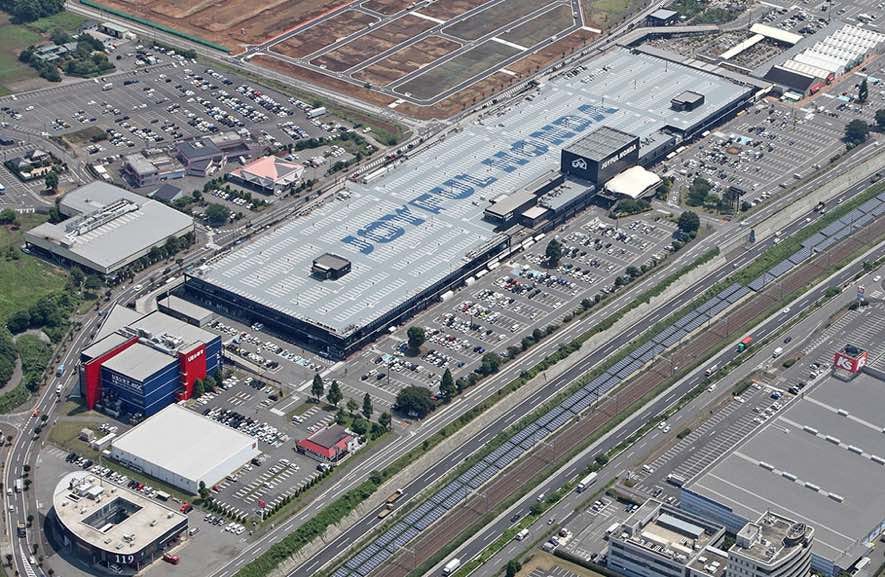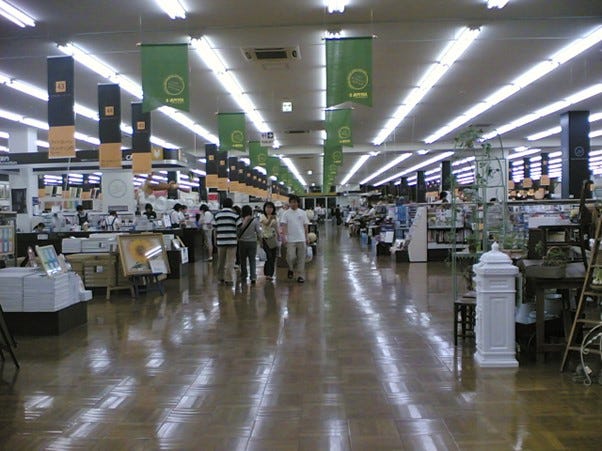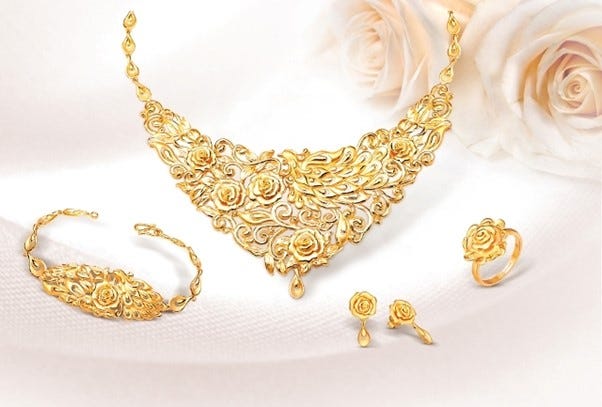The Art of the (Graceful?) Exit
A closer look at when to sell, including two case studies: a Japanese Home Centre Retailer and a Vietnamese Jewellery Company
This Insight is not investment advice and should not be construed as such. Past performance is not predictive of future results. Fund(s) managed by Seraya Investment may be long or short securities mentioned in this Insight. Any resemblance of people or companies mentioned in this Insight to real entities is purely coincidental. Our full Disclaimer can be found here.
This Insight is an extract adapted from the Panah Fund letter to investors for Q2 2017.1
Timing one’s exit from an investment holding is probably one of the most difficult disciplines to master, whether this involves selling a long position or covering a short. If valuations on certain holdings in the portfolio become stretched, we tend to trim over time rather than rushing for the exit, as we have found that momentum can often carry these stocks further than one might expect.
Panah has had fairly low turnover since inception.2 While we aspire towards an ideal holding-period of five years longer for core holdings in the portfolio (particularly ‘compounders’), if new circumstances arise then we must be ready to take a decision to divest. Indeed, if we ever lose confidence in a company and its management – or alternatively our investment thesis – then we do not hesitate to sell quickly. For even if we think the stock price might continue to rise in the near-term, we would prefer to preserve capital rather than prolong our involvement with a company in which we have lost faith.
While such principles might seem reasonable, of course the true difficulties arise when it comes to making actual decisions in real-time. To provide some colour, we have prepared two case studies of sizeable Panah holdings. In both cases, we had hoped to invest for the long term, however new information came to light which persuaded us to divest the holdings quickly and completely.
TABLE OF CONTENTS
Case Study: Japanese Home Centre Retailer (Current Market Cap US ~$1.4bn)
In late 2015, Panah first purchased shares in a Japanese company best described as a ‘home centre’ retailer. The company ranks sixth in Japan by sales for the sector.
Founded in 1975 in Ibaraki, the company operates 15 home centres in the Kanto region, mostly in suburban locations. The company’s six largest stores have a total site area greater than 100,000m² and retail floor area in excess of 50,000m². These home centres are designed to provide a one-stop shop to fulfil all customers’ needs, “with an overwhelming product range and inventory, almost enough to build a whole house”. These centres cater to both retail customers and tradespeople.
The stores sell building materials, timber (with a specialised workroom for wood-cutting), paint, tools (including a power tool repair workshop), hardware, worker essentials, electrical fittings and other materials for home renovation; gardening and plumbing supplies, agricultural materials, and engine machinery (for home gardeners and even farmers); interior furnishings such as wallpaper, carpet and curtains, lighting fixtures, electrical appliances, daily living essentials, daily consumables, fresh cut flowers; storage goods, stationery and office supplies, outdoor goods, automotive accessories, bicycles, medicines, toiletries, and alcoholic and non-alcoholic drinks.
Many of the home centres have separate buildings on site which serve as garden centres, pet superstores, coin laundries, rice milling centres, kerosene and gasoline stations, and even car maintenance workshops. The focus is on selling higher quality Japanese national brands, rather than cheaper and lower quality private-label brands.
Late in his life, the founding chairman decided that the best way for his private company to prosper in the future would be to invite experienced investors to become shareholders, employ professional management and conduct an initial public offering. A leading Japanese private equity firm took a substantial stake (~31%) in 2009, an executive from Mitsubishi was appointed as CEO in 2011, and then the company listed in April 2014. The chairman sadly passed away shortly before the IPO, but not before he had prepared the company for the next chapter in its life.
Panah first came across the firm in early 2015 when it appeared on our value screens, and a recommendation from a trusted advisor followed soon after. Despite the company’s relatively large market capitalisation (larger than US ~$1.0bn at the time), the stock had never been covered by any sell-side analyst. The valuation of the company seemed compelling, ranking within the cheapest 5% of companies within our universe on both a ‘deep value’ and ‘cash flow yield’ basis. Net cash accounted for 65% of the market capitalisation of the company, and the stock was trading on a trailing free cash flow-to-EV yield in the high teens.
After two phone calls with company management earlier in 2015, we finally met with senior executives in December at the company’s largest store, located near Narita Airport in Chiba Prefecture. With an area of 169,000m², this outlet is one of the largest buildings in Japan.
Our conversation revealed that management did not expect any substantial sales growth until the planned launch of a new home centre sometime in the early 2020s. Rather, in the coming years they planned to focus on improving profitability, both by optimising product mix (towards higher margin hardware, and away from homeware) and by rationalising costs.
Management had taken advantage of recent ‘eco capex’ tax breaks to invest in energy-efficient LED lights and air con systems within the stores. They also saw room for improvement in inventory management. There were also plans afoot to introduce loyalty cards and open more specialist stores on their retail sites to increase customer spend. In so doing, management were hopeful that they would be able to move their net profit margin from 2.8% (in FY2015/6)3 to >4% by 2018, and then even higher by 2020 (i.e., closer to the level enjoyed by competitors). The potential boost to profits would be substantial, meaning an implied FY2018/6 EV-to-cash flow multiple of less than 3x.
Management also seemed receptive to the idea of using its large cash pile to increase share buybacks. We were aware that the major private equity shareholder in the firm was looking to sell their holding, and we were optimistic that the company might consent to buy back this 31% stake and cancel the shares, thus creating value for all shareholders.
On the downside, the major risk to our investment thesis appeared to be that the sector (consisting of 200 companies, most unlisted) was fairly crowded, with annual industry sales of JPY 4tn (unchanged since 2000), yet an increase in total stores from 4,000 to 4,600 over the last 15 years. We judged that this risk was somewhat mitigated by the company’s focus on large stores in the Kanto area (where it has a good understanding of its customer base), and by the margin of safety arising from the low valuation.
We initiated a small position in December 2015 shortly after our site visit, then built this holding over the coming months as we gained confidence in our investment thesis.
In March 2016, we were somewhat surprised to learn that rather than the company buying back the ~31% Japanese private equity shareholding in the company, this stake had instead been sold to another international private equity firm. After making direct contact with this new private equity shareholder (including a meeting in Tokyo later in the year), we were reassured.
The firm had a strong track record in Japan and in the retail sector, had known the company for seven years, and had also taken two board seats. They also had a concrete plan of action to introduce global retail standards (including management of storage space, SKUs and tenants), and had posted two members of staff to the company, in operations and finance, to help achieve these goals. Moreover, they were keen to see the company use its liquid balance sheet more efficiently.
The stock price traded sideways into the summer of 2016, and Panah added gently to the holding. The company’s first stock buyback followed in early September. While modest in size, the market nevertheless got excited about the potential for more. The stock price thus rallied strongly in late 2016, despite a somewhat lacklustre trend in sales and profits for the company and the sector.
While we were happy with the upward trend in the stock price, we were less enamoured of fundamental progress as operating results started to fall well short of targets. In December 2016, the company decided to buy land for a new home centre site, although construction would not start for several years. Three months later, there was a disappointing announcement that the company had used a substantial portion of its cash to buy low-yielding land underlying two of its largest stores, and management’s rationale for this important capital allocation decision was disappointingly weak. There was even talk of further land purchases in urban areas to prepare the way for the launch of a new smaller store format.
We saw all these developments – lack of operational progress, sub-optimal allocation of capital, and execution risk on the new store format – as negative. The stock price, however, continued to rally in the first quarter of 2017, pushing valuations up to less attractive levels.
On learning of the land purchases, we trimmed the fund’s holding. We then moved to sell Panah’s entire position around the end of the first quarter of 2017, after ascertaining that these new developments effectively invalidated our original investment thesis. In particular, we judged that management’s aggressive policy of land purchases, would likely prove to be a poor capital allocation decision. The lack of operational progress was also disappointing.
Over the 16 months that Panah held shares in the company, we managed to capture +38% in price appreciation (on a money-weighted basis, in local currency terms) and also received dividends.
In June 2017, after we had exited, it was announced that the company had bought out the entire ~31% stake from its largest shareholder (i.e., the international private equity firm). As far as we are aware, these shares have not yet been cancelled. After reaching a new high in May, the stock price has fallen, giving up all year-to-date gains. Valuations remain stretched.
Case Study: Vietnamese Jewellery Company (Current Market Cap US ~$420mn)
In mid-2015, Panah made its first purchase of shares in Vietnam’s leading jewellery company, having met the company twice earlier that year.4
These purchases occurred during a small crisis of market confidence; the company had decided to make a full provision for an ill-fated non-core investment, in a bank which had weathered the last Vietnamese financial crisis badly and had just been placed under special supervision by the regulator. The stock price of the jewellery company slumped in response to the news as locals and foreigners alike rushed to sell their shares. Various sell-side brokers suspended their ratings as they worried about knock-on effects.
Panah decided to take advantage of this opportunity to establish a position. Foreign shares had previously been rather difficult to source as the company had typically been trading at the maximum Foreign Ownership Limit of 49%, and so we did not want to let this opportunity pass us by. Indeed, the company’s core jewellery retailing business had been performing extremely well, with sales and profit growth of ~+45% in the first half of the year. This included store sales growth of +27%, much faster than Vietnam’s nationwide jewellery sales, as the company grew its market share beyond 21%.
Such rapid retail growth served to underline the company’s commitment – first articulated three years previously – to shift its focus away from gold bullion trading and towards jewellery retail. The full provisioning for the ill-fated bank investment also highlighted a move away from non-core investments; this bank was the company’s last major investment holding, and it had already divested its stake in a fuel distribution firm the previous year and other smaller shareholdings before.
The valuation case also seemed compelling: the stock was at that time trading on a FY2016/12 P/E multiple of just ~9x, and EV/EBITDA multiple of ~7x, despite dominant market share and rapid growth in its jewellery retail operations.
After trading sideways for a few months, the stock broke out to new highs at the end of 2015, and then proceeded to rally sharply during the first half of 2016 as the company reported strong results. In FY2015/12, reported operating profit grew by +55%, and then by a further +23% in H1 FY2016/12. In mid-2016, however, there was another share price wobble for the jewellery company as investors worried that the bank (in which the company still had a 7% stake) would be nationalised.
We decided to add to our holding given that the company had already provisioned fully for its bank investment, and because a ~25% correction in the share price meant that the company was once again trading at an attractive P/E multiple of ~11x. By the end of July 2016, share price appreciation and our subsequent top-ups had boosted this holding to the second largest position in the portfolio.
One of the company’s major shareholders, a private equity firm based in Vietnam which had helped the company refocus on jewellery retail several years earlier, sold out of its substantial holding in the company in H2 2016 as the fund entered its liquidation period. This private equity firm also gave up its board seat, meaning that the jewellery company no longer had any directors with capital markets experience.5
The absence of board members with financial experience became a topic for consideration in late November 2016, when the jewellery company first announced plans for a private placement. We had not expected that it would be necessary to raise new capital so soon given robust operating cash flows. The company also garbled its message concerning the terms for the placement and uses of capital, suggesting to us that it might have been helpful if there were an experienced board whom management could ask for advice on financial matters.
In December 2016, we arranged to visit the senior management of this jewellery company, together with two other significant shareholders of the company: the Apollo Asia Fund6 (which became a shareholder in 2016), and another longstanding Vietnamese investor. This meeting clarified that the main reason for the placement was to increase the pace of store expansion. Although we were not convinced that it was desirable to roll out stores any faster, senior management nevertheless seemed to have the right intentions, and the founder-chairwoman of the company invited us to assist in finding other potential board candidates with financial experience, to help the company manage it finances through this stage of rapid growth.
In early January 2017, we composed a letter to the senior management and directors of the jewellery company, setting out in detail our exact concerns over the proposed share placement and our recommendations for how it might have been handled better, suggestions to improve communications from the company to investors, as well as more general comments concerning stock dilution.7 We also circulated this letter to other major investors in the company. The letter elicited a response from the chairwoman of the jewellery company (in the form of a reassuring letter sent to all investors). This was encouraging, although the letter did not address many of the specific concerns in our original missive.
Over the next six weeks, Panah and the Apollo Asia Fund then expended a fair amount of time and energy liaising with other shareholders and searching for appropriate independent candidates for the board of directors of the jewellery company - as requested by the chairwoman in December. By the time of the company’s proposed deadline in late February, we then informally proposed two board candidates. We were somewhat dismayed when the chairwoman and her colleagues refused to meet either candidate. Initial enthusiasm for shareholder cooperation had apparently vanished after the company managed to locate two new ‘independent’ directors of its own.
By this time, we were also starting to become slightly frustrated that management didn’t seem willing or able to provide the reasons for new developments and various discrepancies in company financials. The jewellery company released provisional results for FY2016/12 in late January, but then substituted this filing for a new one within a fortnight.8 2016 results revealed rising leverage and inventories, which we wanted to understand better. By February, after numerous requests, the company’s new IR representative furnished us with a breakdown of sales and gross profits for 2015 and 2016, but the headline figures did not match the reported financials for either year.
Our confusion was further compounded by the release of audited financials for FY2016/12 in late March. These differed in several respects from the preliminary annual release, although adequate explanations were not forthcoming. In April, a further request for a segmental breakdown of revenues and profits from the company’s IR guru elicited more numbers which didn’t tally. We met with company management once again in March, and then followed up later by email with specific queries to management and to the English-speaking directorial candidate. Unfortunately, the general explanations were inadequate, and our detailed questions by email were ignored.
Fortunately for us, our declining confidence in management stood in sharp contrast to the market’s increasingly upbeat assessment of the jewellery company’s prospects, as management’s bullish updates kick-started another stock price rally in early April. With valuations rising and our confidence in the accuracy of reported numbers at a low ebb, we took advantage of the rising stock price to sell half our holding in late April at a premium to market.9
Our final attempt to understand the situation came in mid-May, when Panah attended the company’s Annual General Meeting (‘AGM’) in Ho Chi Minh City. Sadly, this event undermined any remaining confidence we might have had. A private conversation with one of the new independent directors commenced with the surprising revelation that the stock placement had been cancelled. However, within a few hours this assertion was contradicted in public by the financial controller of the company, raising serious questions about the company’s internal communications.10 At the AGM, it also became clear that the other new ‘independent’ director of the company had previously held a senior position at the troubled bank in which the jewellery company had invested. To us, this suggested that he was neither ‘independent’, nor particularly appropriate as a director.11
Panah divested its remaining position in the jewellery company soon after the AGM (as did the Apollo Asia Fund), then wrote a letter to management explaining why we had decided to sell. During the fund’s holding period of almost two years, Panah captured a price return of more than +70% (money-weighted in local currency terms) and also received dividends. We are disappointed that we had to sell Panah’s holding in a company which is apparently the dominant jewellery retailer in one of Asia’s fastest-growing economies. Given our growing concerns, however, this seemed to be the only reasonable decision to make in the circumstances.
After selling our stake, we did some thinking. There had been some financial discrepancies in previous years, although these were on a much smaller scale than the issues uncovered in FY2016 and were more readily explained by management and by the previous IR representative. Panah still finds it plausible that the irregularities in FY2016 financials were attributable to inadequate internal controls, as well as rapid growth placing unprecedented strain on operations and financing. Given the lack of feedback from the company, however, we are not in a position to judge whether this explanation is correct, or even whether the company’s reported financials are accurate.
The timing of the proposed share placement, first announced in late 2016, hints at unexpected cash flow pressure. While one explanation for this capital raise might indeed have been to accelerate the store rollout plan, another important factor might have been a substantial unexpected tax payment demand in late 2016. This also seems to have placed pressure on the company’s finances.12
At present, however, such explanations remain post hoc guesswork, and we have little clarity as to the true state of affairs. This experience has, however, been a valuable one, and we will seek to apply the lessons learnt when considering future investment opportunities in Vietnam.
In the interests of transparency, we have shared some of our specific concerns in more detail with other local, engaged Vietnamese investors in this jewellery company. We hope that they have more luck than us in trying to investigate these discrepancies, and also manage to encourage the company to communicate better with investors.
Until that day, however, Panah will remain an interested observer of the company’s progress rather than an owner of its equity.
Thank you for reading.
Andrew Limond
The original source material has been edited for spelling, punctuation, grammar and clarity. Photographs, illustrations, diagrams and references have been updated to ensure relevance. Copies of the original quarterly letter source material are available to investors on request.
Turnover since inception on Panah’s long positions implies an average holding period of longer than three years.
The fiscal years of 2015 and 2016.
Our initial investment thesis was laid out in the Panah Fund letter to investors for Q2 2016, as well as the following Seraya Insight: ‘The Investment Case for Vietnam’.
Another financial investor had also withdrawn a director after a general change of policy on board seats.
Apollo Asia, managed by Claire Barnes, is Panah’s sister fund at AIMS Asset Management Sdn Bhd. Panah and Apollo Asia occasionally have overlapping interests. Panah would like to thank Claire Barnes for her wise counsel in relation to this jewellery company. (Note that AIMS Asset Management was the investment manager for Panah from inception to November 2019; Panah is now managed by Seraya Investment, whereas Apollo Asia continues to be managed by AIMS Asset Management Sdn Bhd.)
In our experience, share dilution resulting from placements and employee stock ownership plans are often poorly understood by company management in Vietnam.
The substitution occurred without highlighting this switch, without giving a reason for changes in the numbers (and the reasons for it), and without preserving the original filing (the new filing was effectively backdated). The new filing included lower profit and cash flow compared to the original. Vietnamese and English versions differed.
Despite the strong rally, foreign investors were still willing to pay a premium to market price to buy a block.
The placement is underway at present.
The lack of independence and appropriateness of this new board candidate was probably the reason that the company did not fulfil its original promise to inform us of this new director’s candidacy in a timely manner. Instead, the company just met the regulatory deadline to make a disclosure (only two days before the AGM).







